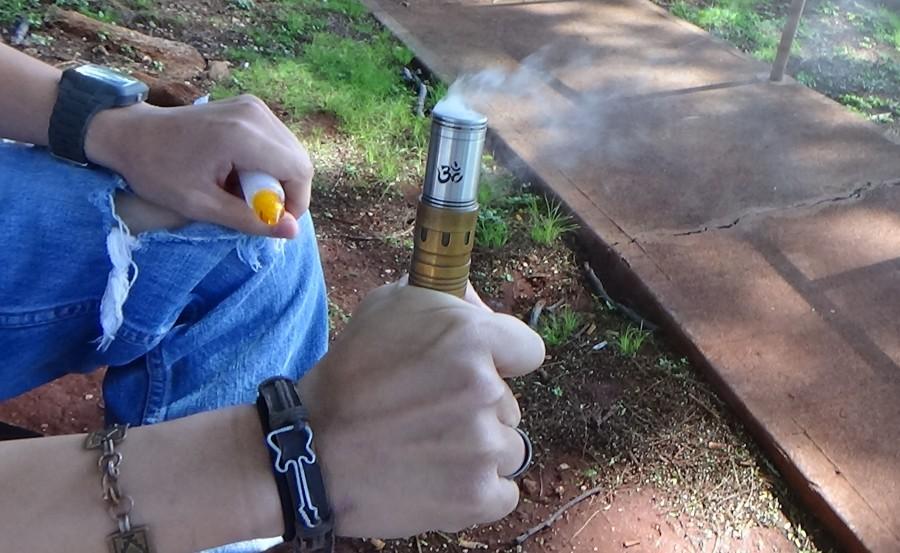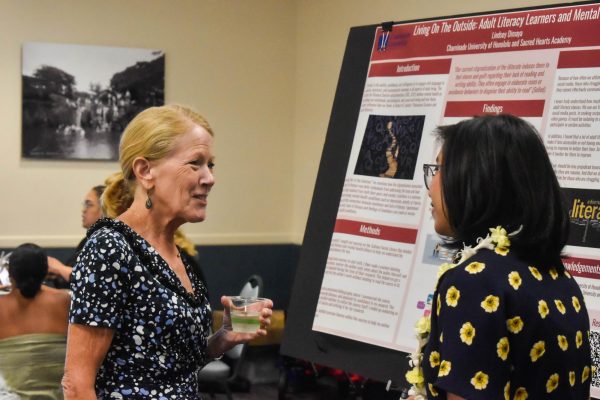Breathe in and breathe smoke?
Students are able to utilize designated smoking areas around campus.
December 4, 2015
The students of Chaminade University were recently given a chance to speak on the issue of smoking cigarettes and e-cigarettes on campus through an online student survey.
The results have not been released, but in an unscientific poll around campus consisting of 30 students, they were overwhelmingly in support of designated smoking areas.
In order for the student body to have a better understanding of their peers’ view on the matter, a personal hands-on survey was conducted among 30 students on campus of varying demographics.
The survey was broken down into three responses: smoking should be permitted anywhere on campus, smoking should be banned completely, and designated areas should be the smoking areas. Out of the 30 people surveyed, 100 percent had agreed that designated smoking areas would be the proper response.
The school has implemented this policy in accordance with the Hawaii state law passed in 2006. However, there were varying extremes on where and how these smoking areas should be handled.
Seven of the 30 students felt that the current areas were still posing a health hazard to anyone who is in the vicinity. They felt that some of the areas were still too close to populated locations on the campus.
“It’s one of the those things that I’m concerned about because people who have asthma like I do … that’s something that we have to watch out for because it can trigger an attack and that’s something we have to constantly watch out for,” said senior Matt Manosca, who has asthma.
Manosca was one of the students who had felt that it was best to move the current location of some of the smoking areas, such as the one across from Eiben Hall by the tree and bench. He said it was still too risky to continue utilizing that area because many people are still in that vicinity.
“I feel like the spot they’re on now is kinda iffy,” he said. “But, I feel like they can move it a little bit farther because there are these kids who also have a severity of asthma. So I mean … if one of those kids inhales and they just start having an attack, then who’s responsible for that? Is that the school or the person smoking?”
Roughly three of the 30 students felt that were being too adamant against smoking. These students were all smokers that they were unsatisfied with the current locations of the smoking areas. Many of these areas were seen as too far out of the way and away from central facilities on the campus. Others had said that the entire campus should be allowed as an area to smoke, as long it is not populated at the time.
Twenty-one-year-old Ryota Takahara said that he would prefer if the school added another smoking area near the swinging bench near the Behavioral Sciences stairwell, since there are few people in that part of the campus.
A number of students also expressed that they were concerned with the negligence of others who freely use the e-cigarettes wherever they want. Many complained of the smell and also debated the potential harm that could be involved in the second-hand inhaling of the smoke.
“Second-hand smoke (from conventional cigarettes) contains more than 7,000 chemicals. Hundreds are toxic and about 70 can cause cancer. ,” according to the Center for Disease Control and Prevention on March 5, 2014. “Since the 1964 Surgeon General’s Report, 2.5 million adults who were nonsmokers died because they breathed second-hand smoke.”
E-cigarettes seem to possess a number of harmful qualities as well.
Professor Constantinos Sioutas at USC Viterbi School of Engineering conducted a study on the harmful effects of e-cigarettes.
“Our results demonstrate that overall electronic cigarettes seem to be less harmful than regular cigarettes, but their elevated content of toxic metal such as nickel and chromium do raise concerns.” Sioutas said.
Chaminade has not made a new decision to alter the current smoking policies.














